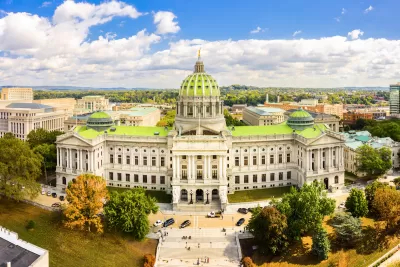“We don’t need every old coal miner’s house” to stay standing, says Sen. David Argall (R-Schuylkill).

Pennsylvania legislators approved legislation that would remove roadblocks for blight reduction efforts of land banks in Pittsburgh and other cities in Allegheny County. The bill was signed into law by Pennsylvania Governor Josh Shapiro this week.
The bill “would let land banks in Pittsburgh and other Allegheny County municipalities use a faster process to obtain a clear title to blighted properties,” reported For Turner for the Pittsburgh Post-Gazette in June. Turner was also the source of the news that Gov. Shapiro has signed the bill, via Twitter.
The primary sponsor of the legislation, Sen. Wayne Fontana (D-Allegheny) is quoted extensively in the June article, including crediting a bill that stalled in last year’s legislative session for providing the model for the blight reduction plan.
Blight is a statewide issue in Pennsylvania, where population declines are connected to the loss of employers. “Blight is often tied to population drops that occur when a key employer like a coal mine or a steel mill closes, but population declines also can be triggered by other causes,” explains Turner.
Sen. David Argall (R-Schuylkill) the sponsor of last year’s bill, is quoted in the article saying, “We don’t need every old coal miner’s house” to stay standing. Senators Argall and Fontana hope that by giving municipalities “more tools in the toolbox,” they can be more effective at reducing blighted properties.
FULL STORY: A bill to help Pittsburgh fight blight is close to passing as Pa. lawmakers continue budget talks

Rethinking Redlining
For decades we have blamed 100-year-old maps for the patterns of spatial racial inequity that persist in American cities today. An esteemed researcher says: we’ve got it all wrong.

Planetizen Federal Action Tracker
A weekly monitor of how Trump’s orders and actions are impacting planners and planning in America.

Walmart Announces Nationwide EV Charging Network
The company plans to install electric car chargers at most of its stores by 2030.

Seattle’s Pike Place Market Leans Into Pedestrian Infrastructure
After decades of debate, the market is testing a car ban in one of its busiest areas and adding walking links to the surrounding neighborhood.

The World’s Longest Light Rail Line is in… Los Angeles?
In a city not known for its public transit, the 48.5-mile A Line is the longest of its kind on the planet.

Quantifying Social Infrastructure
New developments have clear rules for ensuring surrounding roads, water, and sewers can handle new users. Why not do the same for community amenities?
Urban Design for Planners 1: Software Tools
This six-course series explores essential urban design concepts using open source software and equips planners with the tools they need to participate fully in the urban design process.
Planning for Universal Design
Learn the tools for implementing Universal Design in planning regulations.
City of Moorpark
City of Tustin
City of Camden Redevelopment Agency
City of Astoria
Transportation Research & Education Center (TREC) at Portland State University
Regional Transportation Commission of Southern Nevada
Toledo-Lucas County Plan Commissions




























